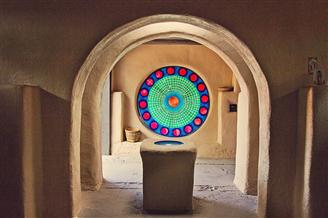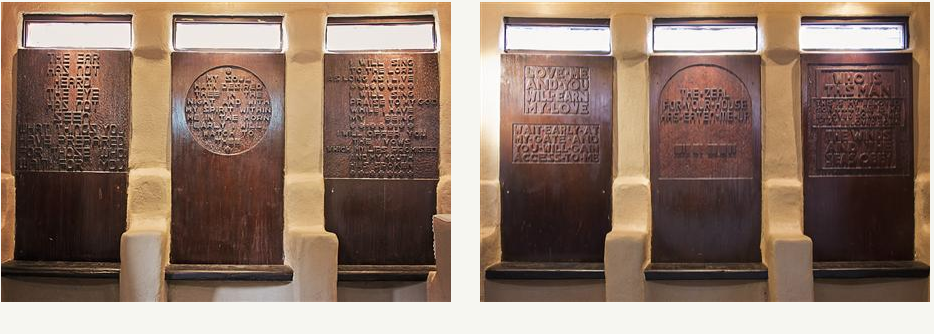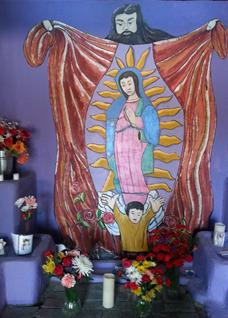The Windows

The chapel contains an impressive window that was created and made especially for the Sagrada. (Three other windows were also created for the Sagrada, and Sister Giotto herself considers the whole group of four to be her most significant body of work.)
Of the original group of four, only one is known to be still serving today as a functional window letting in light. This one is the large striking window to the left of the entryway to the Chapel. Titled Feast Days of the Virgin and Phases of the Moon, and a favorite photographic subject of chapel visitors, it is in reality a rather complex calendar of Marian Feast Days.
 The center of this window stands for the sun. Surrounding the center is a light-blue ring intended to represent the sky. A web between the two symbolizes the calendar days of a single year, and the dark-blue outermost rim containing red circles shows the order of the cycles of the moon in one calendar year.
The center of this window stands for the sun. Surrounding the center is a light-blue ring intended to represent the sky. A web between the two symbolizes the calendar days of a single year, and the dark-blue outermost rim containing red circles shows the order of the cycles of the moon in one calendar year.
The chapel’s second window, now stored, was originally in the Sagrada gallery. It is titled The Seven Days of Creation.
The third window, also now stored, was once in the restaurant “Joseph’s Kitchen.” Its title is Seasons of the Year.
The fourth window is in the possession of Antoine Predock, a prominent Albuquerque architect. It was given to him in exchange for drawing up the blueprints needed to construct the Sagrada. This last window depicts the coming of the Light of the World.
In connection with the original group of four windows, it is worth knowing that Sister Giotto associates the light of the sun with the spiritual Light that is Christ. Catholicism celebrates events in the life of Christ throughout the year beginning with his birth at Christmas. (From the summer solstice until the winter solstice, the light gradually decreases in the Northern Hemisphere; then from the winter solstice—very nearly synchronized with Christmas—the light increases again until the next year’s summer solstice is reached.)
Wooden Panels
Six wooden benches lining the adobe walls of the sanctuary, three on each side, underscore wooden panels hanging directly above them, each panel hand-carved with a different verse of Scripture.

The panels were carved by Sister Giotto and renowned artist Meinrad Craighead. The panels were then stained and lettered in slightly different shades, to subtly illustrate the difference between the energy of the letters and the natural wood material from which the lettering emerges.
When Sister Giotto was asked if it would be appropriate to color-highlight the carved scriptures to make them easier for people visiting the Chapel to read, she replied, “The letters are not meant to be painted. The natural material of the panels resonates with a completely different energy than if it were painted. The spiritual/feminine side of life is not meant to be easy and available and visible. That’s why if you want to be able to read what’s on the panels you have to walk up CLOSELY and INTIMATELY to SEE the words. In being so close you may want to FEEL the ‘doors’ with your fingers and SMELL the wood. The feminine pulls you in to experience the BELOVED. When you have this experience it fills your body, and when you feel the BELOVED, He enters your heart. This is what the prayer, meditation and quiet interaction is that feeds us spiritually.”
Today, the panels are maintained in a state as near to their original one as possible. Unfortunately, after the Chapel was damaged by smoke from a fire in 2010, they had to be refinished. Their profound feminine subtlety is now more difficult to sense, yet they continue to usher visitors into quiet contemplation and prayer in the presence of comforting words from Scripture.
The Shrine

The chapel was dedicated to Our Lady of Guadalupe because of the love the Spanish and Native Americans in New Mexico, as well as the general public, have for her. She is the Patroness of the Americas, and as one of us, her kindness, compassion and forgiveness spurs us on to love one another.
–Sister Giotto Moots
Many weddings and celebrations of life have been held here. Because the Chapel is such an appealing refuge for reflection, prayer and meditation, visitors often return to celebrate the memory of their loved ones. Flowers are often left as a tribute to her along with prayer requests and notes of gratitude. Candles are not permitted due to fire hazard.
